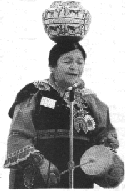
"We are grateful, O Mother Earth, for the mountains and the
streams
where the deer, by command of Thy Breath of Life, wander.
Wishing for
you the fullness life, we shall go forth prayerfully upon the
the
trails of our Earth Mother."
Zuni Prayer
Stories
Four Flutes
Hummingbird
Swift-Runner and Trickster Tarantula
Zuñi
Folk
Tales
by FRANK HAMILTON CUSHING
Foreword by JOHN WESLEY POWELL [1901]
The Zuni nation
of North American Indians have lived in the
area of the present states of New Mexico and Arizona over 1,000
years
prior to the coming of the Europeans. They are thought to be
direct
descendants of the Anasazi.
A large,
thriving Zuni Pueblo was discovered in 1500 by Franciscans from
Mexico, who returned with glowing reports of the Zuni "Kingdom of
Cibola" on the Zuni River. Concerned about attacks, Zuni leaders
moved their women, children, and property to their stronghold
Mesa, to which they escaped when Coronado tried to subjugate the
nation. In 1629, about 10,000 Zunis were accounted for when the
first mission was established in Hawikuh by the Franciscans. When
first
contacted by Spanish explorers during the 16th century, the Zuni
were
living in seven villages that came to be associated with the
mythical
Seven Golden Cities of CIBOLA. After the unsuccessful Pueblo
rebellion
against the Spanish in 1680, the Zuni were consolidated within the
present pueblo, which was constructed (c.1695) on the site of one
of
the original villages.
Primarily
farmers, the Zuni raise maize and wheat and engage in
sheepherding on a large scale. Jewelrymaking has become an
important
additional source of income. Traditional Zuni life is oriented
around a
matrilineal clan system and a complex ceremonial system based on a
belief in the ancestors (ancient ones). There are six specialized
esoteric groups, each with restricted membership and its own
priesthood, devoted to the worship of a particular group of
supernaturals. During the well-known Shalako Festival, held in
early
winter, dancers wearing giant masks represent the couriers of the
rain
deities as they come to bless new homes. Today, they remain a
strong
nation, active on the Zuni Reservation in New Mexico. The Zuni
population in 1991 was estimated at 8,546.
![Zuni dancers: detail of
photograph by Edward Curtis: 1914, [public domain]](images/zunidanc.jpg)
Zuni dancers
Adding
a
Breath to Zuni Life
Zuni
Fetish
Collection
Zuni
Pueblo
"She-We-Na"
Zuni
World
View, on the Beautiful and the Dangerous
 Return to
Indigenous Peoples' Literature
Return to
Indigenous Peoples' Literature
Compiled by: Glenn Welker
Copyright © 1993-2013
This page last updated 05/30/2019 21:53:00
This site has been accessed over 10,000,000 times since
February 8,
1996.

![Zuni dancers: detail of
photograph by Edward Curtis: 1914, [public domain]](images/zunidanc.jpg)
 Return to
Indigenous Peoples' Literature
Return to
Indigenous Peoples' Literature